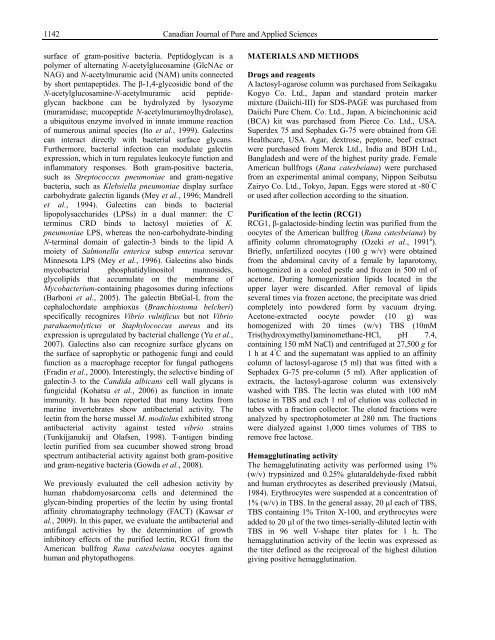Download (5Mb) - Covenant University Repository
Download (5Mb) - Covenant University Repository
Download (5Mb) - Covenant University Repository
You also want an ePaper? Increase the reach of your titles
YUMPU automatically turns print PDFs into web optimized ePapers that Google loves.
1142<br />
surface of gram-positive bacteria. Peptidoglycan is a<br />
polymer of alternating N-acetylglucosamine (GlcNAc or<br />
NAG) and N-acetylmuramic acid (NAM) units connected<br />
by short pentapeptides. The β-1,4-glycosidic bond of the<br />
N-acetylglucosamine-N-acetylmuramic acid peptideglycan<br />
backbone can be hydrolyzed by lysozyme<br />
(muramidase; mucopeptide N-acetylmuramoylhydrolase),<br />
a ubiquitous enzyme involved in innate immune reaction<br />
of numerous animal species (Ito et al., 1999). Galectins<br />
can interact directly with bacterial surface glycans.<br />
Furthermore, bacterial infection can modulate galectin<br />
expression, which in turn regulates leukocyte function and<br />
inflammatory responses. Both gram-positive bacteria,<br />
such as Streptococcus pneumoniae and gram-negative<br />
bacteria, such as Klebsiella pneumoniae display surface<br />
carbohydrate galectin ligands (Mey et al., 1996; Mandrell<br />
et al., 1994). Galectins can binds to bacterial<br />
lipopolysaccharides (LPSs) in a dual manner: the C<br />
terminus CRD binds to lactosyl moieties of K.<br />
pneumoniae LPS, whereas the non-carbohydrate-binding<br />
N-terminal domain of galectin-3 binds to the lipid A<br />
moiety of Salmonella enterica subsp enterica serovar<br />
Minnesota LPS (Mey et al., 1996). Galectins also binds<br />
mycobacterial phosphatidylinositol mannosides,<br />
glycolipids that accumulate on the membrane of<br />
Mycobacterium-containing phagosomes during infections<br />
(Barboni et al., 2005). The galectin BbtGal-L from the<br />
cephalochordate amphioxus (Branchiostoma belcheri)<br />
specifically recognizes Vibrio vulnificus but not Vibrio<br />
parahaemolyticus or Staphylococcus aureus and its<br />
expression is upregulated by bacterial challenge (Yu et al.,<br />
2007). Galectins also can recognize surface glycans on<br />
the surface of saprophytic or pathogenic fungi and could<br />
function as a macrophage receptor for fungal pathogens<br />
(Fradin et al., 2000). Interestingly, the selective binding of<br />
galectin-3 to the Candida albicans cell wall glycans is<br />
fungicidal (Kohatsu et al., 2006) as function in innate<br />
immunity. It has been reported that many lectins from<br />
marine invertebrates show antibacterial activity. The<br />
lectin from the horse mussel M. modiolus exhibited strong<br />
antibacterial activity against tested vibrio strains<br />
(Tunkijjanukij and Olafsen, 1998). T-antigen binding<br />
lectin purified from sea cucumber showed strong broad<br />
spectrum antibacterial activity against both gram-positive<br />
and gram-negative bacteria (Gowda et al., 2008).<br />
We previously evaluated the cell adhesion activity by<br />
human rhabdomyosarcoma cells and determined the<br />
glycan-binding properties of the lectin by using frontal<br />
affinity chromatography technology (FACT) (Kawsar et<br />
al., 2009). In this paper, we evaluate the antibacterial and<br />
antifungal activities by the determination of growth<br />
inhibitory effects of the purified lectin, RCG1 from the<br />
American bullfrog Rana catesbeiana oocytes against<br />
human and phytopathogens.<br />
Canadian Journal of Pure and Applied Sciences<br />
MATERIALS AND METHODS<br />
Drugs and reagents<br />
A lactosyl-agarose column was purchased from Seikagaku<br />
Kogyo Co. Ltd., Japan and standard protein marker<br />
mixture (Daiichi-III) for SDS-PAGE was purchased from<br />
Daiichi Pure Chem. Co. Ltd., Japan. A bicinchoninic acid<br />
(BCA) kit was purchased from Pierce Co. Ltd., USA.<br />
Superdex 75 and Sephadex G-75 were obtained from GE<br />
Healthcare, USA. Agar, dextrose, peptone, beef extract<br />
were purchased from Merck Ltd., India and BDH Ltd.,<br />
Bangladesh and were of the highest purity grade. Female<br />
American bullfrogs (Rana catesbeiana) were purchased<br />
from an experimental animal company, Nippon Seibutsu<br />
Zairyo Co. Ltd., Tokyo, Japan. Eggs were stored at -80 ° C<br />
or used after collection according to the situation.<br />
Purification of the lectin (RCG1)<br />
RCG1, β-galactoside-binding lectin was purified from the<br />
oocytes of the American bullfrog (Rana catesbeiana) by<br />
affinity column chromatography (Ozeki et al., 1991 a ).<br />
Briefly, unfertilized oocytes (100 g w/v) were obtained<br />
from the abdominal cavity of a female by laparotomy,<br />
homogenized in a cooled pestle and frozen in 500 ml of<br />
acetone. During homogenization lipids located in the<br />
upper layer were discarded. After removal of lipids<br />
several times via frozen acetone, the precipitate was dried<br />
completely into powdered form by vacuum drying.<br />
Acetone-extracted oocyte powder (10 g) was<br />
homogenized with 20 times (w/v) TBS (10mM<br />
Tris(hydroxymethyl)aminomethane-HCl, pH 7.4,<br />
containing 150 mM NaCl) and centrifuged at 27,500 g for<br />
1 h at 4 ° C and the supernatant was applied to an affinity<br />
column of lactosyl-agarose (5 ml) that was fitted with a<br />
Sephadex G-75 pre-column (5 ml). After application of<br />
extracts, the lactosyl-agarose column was extensively<br />
washed with TBS. The lectin was eluted with 100 mM<br />
lactose in TBS and each 1 ml of elution was collected in<br />
tubes with a fraction collector. The eluted fractions were<br />
analyzed by spectrophotometer at 280 nm. The fractions<br />
were dialyzed against 1,000 times volumes of TBS to<br />
remove free lactose.<br />
Hemagglutinating activity<br />
The hemagglutinating activity was performed using 1%<br />
(w/v) trypsinized and 0.25% glutaraldehyde-fixed rabbit<br />
and human erythrocytes as described previously (Matsui,<br />
1984). Erythrocytes were suspended at a concentration of<br />
1% (w/v) in TBS. In the general assay, 20 µl each of TBS,<br />
TBS containing 1% Triton X-100, and erythrocytes were<br />
added to 20 µl of the two times-serially-diluted lectin with<br />
TBS in 96 well V-shape titer plates for 1 h. The<br />
hemagglutination activity of the lectin was expressed as<br />
the titer defined as the reciprocal of the highest dilution<br />
giving positive hemagglutination.

















